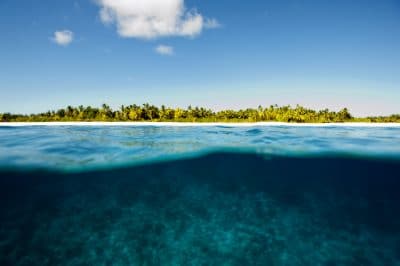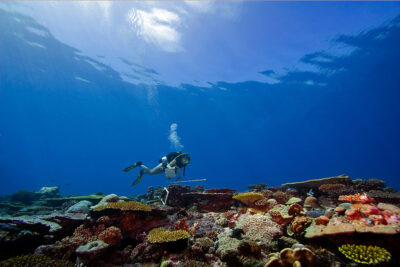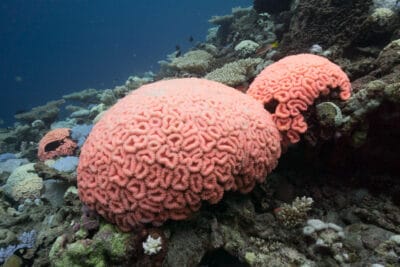Last Stop on the Global Reef Expedition
(2021)
Please find an excerpt of the full PDF below

Chagos News
July 23, 2021
By Liz Thompson
Scientists aboard the Global Reef Expedition – the largest systematic coral reef survey and mapping expedition in history – travelled to Chagos Archipelago to explore its remote coral reefs. What they found were reefs teeming with life, but also worrying signs of the unfolding coral reef crisis.
The Khaled bin Sultan Living Oceans Foundation conducted a Global Reef Expedition to assess coral reef status and resiliency around the world.
The Expedition took 10 years and circumnavigated the globe, visiting more than 1,000 reefs in 15 countries in the Atlantic, Pacific and Indian Oceans and their associated seas.
The Global Reef Expedition surveyed coral and fish communities on some of the most remote coral reefs on Earth, and there is no better place for this than the Indian Ocean’s Chagos Archipelago.
In 2015, an international team of scientists arrived on the archipelago to carry out its final Global Reef Expedition research mission.
Over the course of two months at sea, the scientists conducted thousands of surveys of the benthic and reef fish communities at over 100 locations.

The last great coral reef
Because of its remote location and protected status, Chagos Archipelago is the perfect place to study global issues such as climate change and overfishing that threaten the long-term survival of coral reefs.
Around the world, reefs are declining due to a variety of human impacts, including coastal development, fishing and pollution, but on the archipelago these local pressures are absent since it is uninhabited, save for the military base on Diego Garcia. Prior to the expedition, estimates indicated the Chagos Archipelago could contain more than half of the healthy reefs remaining in the Indian Ocean.
What the Global Reef Expedition found was a stark reminder that the coral reef crisis is affecting reefs everywhere, even in the last great coral reef wilderness on Earth.
When the research mission in the Chagos Archipelago began, scientists found reefs that were truly exceptional; they had some of the highest density of coral and fish recorded on the entire Global Reef Expedition.
Reefs were teeming with schools of jacks and snappers, swarms of small fish clung to the reefs, and large fish such as groupers, sharks and rays were found throughout the area.
The archipelago had a diverse assemblage of corals and an astounding abundance and diversity of life in the water and on the seafloor.
However, towards the end of the research mission, the scientists witnessed the beginning of what would become a catastrophic and global coral bleaching event.

A global coral bleaching event
In the clear and unusually calm waters of the Indian Ocean, scientists watched as a warming ocean bleached reefs before their eyes.
During the first signs of bleaching, corals turned vibrant, almost neon-coloured shades of pink, blue and yellow before turning white, as the corals tried to protect themselves from the sun’s harmful rays after losing their symbiotic algae.
As the warm waters persisted, the extent of the bleaching was readily apparent and impacted the vast majority of the shallow-water corals.
There was hope that corals of Chagos Archipelago would bounce back to health relatively quickly. But a study after the bleaching event found live coral fell dramatically from the relatively healthy 31–52% observed on the Global Reef Expedition, to only 5–15% shortly after.
Since then, there have been promising signs the reefs are recovering, but it is unlikely that the reefs will regain their high coral cover for at least a decade.
Because the Global Reef Expedition was the last research mission to survey the reefs prior to the bleaching, the Living Ocean Foundation’s findings will be extremely useful to marine managers as they assess the impact of the bleaching event and monitor how the reefs are recovering over time.
The scientific findings from the research mission were recently published in The Global Reef Expedition: Chagos Archipelago Final Report.
This report contains detailed information on the diversity and abundance of corals and reef fish species, along with valuable baseline data on the state of the reefs at a point in time. This report can help government agencies, conservation organizations and scientists manage and conserve reefs in the archipelago.
Will the archipelago’s reefs survive?
The world has lost 50% of its coral reefs in the past 30 years. The rest could be gone by the end of the century if nothing is done to save them.
With the increased frequency of coral bleaching due to a changing climate, combined with growing human impact including overfishing and pollution, coral reefs face an uphill battle to survive.
However, the reefs of the Chagos Archipelago face some of the best odds of survival, despite this recent bleaching event. They are protected, relatively free from human influence and they still contain large and healthy fish populations and a stunning diversity of life.
This diversity may be helping the reefs recover from bleaching and may also be one of the key factors that could help these reefs survive well into the future.
The Global Reef Expedition mission to the Chagos Archipelago gave scientists the chance to study pristine coral reefs.
Their findings illustrate what remarkable places coral reefs can be when given the opportunity to thrive, but they also highlight the perils all reefs face in a changing world.
